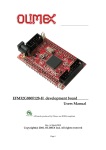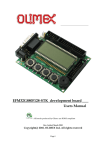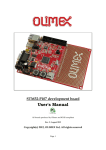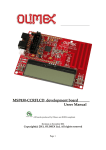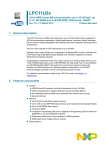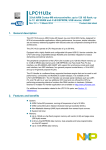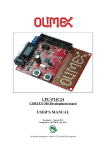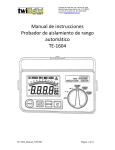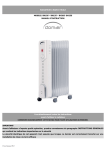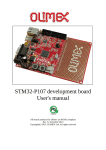Download LPC-P1343 development board user`s manual
Transcript
LPC-P1343 development board user's manual All boards produced by Olimex are ROHS compliant Revision C, February 2013 Copyright(c) 2011, OLIMEX Ltd, All rights reserved INTRODUCTION LPC-P1343 is a development board with LPC1343 ARM Cortex-M3 based microcontroller for embedded applications from NXP. LPC-P1343 featuring a high level of integration and low power consumption. This microcontroller supports various interfaces such as one Fast-mode Plus I2C-bus interface, USB, UART, SSP interfaces, four general purpose timers, a 10-bit ADC. On the board are available UEXT, Debug Interface, user buttons, USB device and user LEDs. This allows you to build a diversity of powerful software that can be used in a wide range of applications. BOARD FEATURES • MCU: LPC1343 Cortex-M3, up to 70 MHz, 32 kB Flash, 8kB SRAM, UART RS-485, USB, SSP, I2C/Fast+, ADC • Power supply circuit • Power-on led • USB connector and functionality • USBC LED • Debug interface – SWD (Serial Wire Debug) • UEXT connector • Eight user LEDs • Two user buttons • Reset button • Prototype area • FR-4, 1.5 mm, red soldermask, white component print • Dimensions:80x50mm (3.15 x 1.97") ELECTROSTATIC WARNING The LPC-P1343 board is shipped in protective anti-static packaging. The board must not be subject to high electrostatic potentials. General practice for working with static sensitive devices should be applied when working with this board. BOARD USE REQUIREMENTS Cables: The cable you will need depends on the programmer/debugger you use. For instance, if you use https://www.olimex.com/Products/ARM/JTAG/ARMJTAG-COOCOX/, you will need USB A-B cable. Hardware: Programmer/debugger or other compatible programming/debugging tool with SWD interface. The only Olimex programmer that has SWD interface at the moment is ARM-JTAG-COOCOX – https://www.olimex.com/Products/ARM/JTAG/ARM-JTAG-COOCOX. OpenOCD debuggers (ARM-JTAG-TINY, ARM-JTAG-TINY-H, ARM-JTAG-OCD, ARM-JTAG-OCD-H) can also be adapted to work with SWD interface by getting https://www.olimex.com/Products/ARM/JTAG/ARM-JTAG-SWD/. NOTE that at the current moment only Rowley Crossworks supports this combination. PROCESSOR FEATURES LPC-P1343 board use ARM Cortex™-M3 microcontroller LPC1343FBD48/301 from NXP Semiconductors with these features: – ARM Cortex-M3 processor, running at frequencies of up to 72 MHz – ARM Cortex-M3 built-in Nested Vectored Interrupt Controller (NVIC). – 32kB on-chip flash programming memory. Enhanced flash memory accelerator enables high- peed 72 MHz operation with zero wait states – In-System Programming (ISP) and In-Application Programming (IAP) via on-chip bootloader software. – Serial interfaces: - USB 2.0 full-speed device controller with on-chip PHY for device - UART with fractional baud rate generation, modem, internal FIFO and RS-485/EIA-485 support. - SSP controller with FIFO and multi-protocol capabilities. - I2C-bus interface supporting full I2C-bus specification and Fastmode Plus with a data rate of 1 Mbit/s with multiple address recognition and monitor mode. – Other peripherals: - 42 General Purpose I/O (GPIO) pins with configurable pullup/down resistors and a new, configurable open-drain operating mode. - Four general purpose timers/counters, with a total of four capture inputs and 13 match outputs. - Programmable WatchDog Timer (WDT). - System tick timer. – Serial Wire Debug and Serial Wire Trace Port. – High-current output driver (20 mA) on one pin. – High-current sink drivers (20 mA) on two I2C-bus pins in Fast-mode Plus. – Integrated PMU (Power Management Unit) to minimize power consumption during Sleep, Deep-sleep, and Deep power-down modes. – Three reduced power modes: Sleep, Deep-sleep, and Deep power-down. – Single 3.3 V power supply (2.0 V to 3.6 V). – 10-bit ADC with input multiplexing among 8 pins. – 40 GPIO pins can be used as edge and level sensitive interrupt sources. – Clock output function with divider that can reflect the main oscillator clock, IRC clock, CPU clock, Watchdog clock, and the USB clock. – Processor wake-up from Deep-sleep mode via GPIO interrupts. – Brownout detect with four separate thresholds for interrupt and one threshold for forced reset. – Power-On Reset (POR). – Crystal oscillator with an operating range of 1 MHz to 25 MHz. – 12 MHz internal RC oscillator trimmed to 1 % accuracy that can optionally be used as a system clock. – PLL allows CPU operation up to the maximum CPU rate without the need for a high-frequency crystal. May be run from the main oscillator, the internal RC oscillator, or the Watchdog oscillator. – Code Read Protection (CRP) with different security levels. BLOCK DIAGRAM MEMORY MAP red red red R4 10k red R5 10k red R6 10k red 3.3V OUT R21 390R/1% R20 240R/1% 100nF C8 R19 560R PWR GND_PIN GND + IT1185AU2 RESET RSTN R18 10k BUT2 T1157 BUT1 T1157 WAKE_UP http://www.olimex.com/dev COPYRIGHT(C), 2009 Rev. Initial BH10S BH10S BH10S BH10S BH10S BH10S BH10S BH10S BH10S BH10S UEXT UEXT-1 UEXT-2 TXD UEXT-3 RXD UEXT-4 SCL UEXT-5 SDA UEXT-6 MISO UEXT-7 MOSI/SWV UEXT-8 SCK UEXT-9 CS UEXT-10 3.3V LPC-P1343 R17 10k R15 2.0k 3.3V 3.3V R16 2.0k 3.3V LPC1343FBD48 41 44 19 20 33 34 35 39 40 45 46 47 9 17 30 42 VBUS DD+ ID GND USB R14 560R 47k R13 1.5k/1% #USB_CONNECT USBC yellow MICRO_B C7 10nF USB_VBUS DR11 D+ R12 C6 33R 33R U2DDU2D+ D+ 3.3V_CORE_E 44 1 2 3.3V C4 CLOSE 41 100nF 19 20 RXD TXD SWD WAKE_UP P1_0 P1_1 P1_2 P1_3 P1_4 P1_5 P1_6 P1_7 P1_8 P1_9 P1_10 P1_11 33 34 35 39 40 45 46 47 9 17 30 42 GND3 GND4 C9 10uF/6.3V/TANT IN 3.3V 2 13 26 38 18 21 1 11 12 24 25 31 36 37 43 48 RST P0_1 P0_2 P0_3 SCL P0_4 SDA P0_5 #USB_CONNECT P0_6 P0_7 MISO P0_8 MOSI/SWV P0_9 SWC P0_10 P0_11 RSTN 3 4 10 14 15 16 22 23 27 28 29 32 BLD_E R10 1k C5 3.3V T1 DTA114YKA 18p(NA) ADJ/GND 3.3V USER 2 13 26 38 18 21 1 11 12 USER 24 CS 25 SCK 31 P2_0 P2_1 P2_2 P2_3 P2_4 P2_5 P2_6 P2_7 P2_8 P2_9 P2_10 P2_11 BUTTONS 36 37 43 48 C3 5 8 6 6 Q1 12MHz/20pF 7 7 P3_0 P3_1 P3_2 P3_3 27pF C2 5 8 3 4 10 14 15 16 22 23 27 28 29 32 10k HN1x2 10k 1k 18p(NA) +5V_JLINK D1 BAT54C VR1(3.3V) LM1117IMPX-ADJ 3.3V 3.3V 560R R4 R3 R2 R1 R-MAT2 560R R4 R3 R2 R1 R-MAT1 27pF 100nF C1 USB_VBUS #RESET/PIO0_0 PIO0_1/CLKOUT/CT32B0_MAT2/USB_FRAME_TOGGLE PIO0_2/SSEL/CT16B0_CAP0 VDDIO PIO0_3/USB_VBUS PIO0_4/SCL PIO0_5/SDA PIO0_6/#USB_CONNECT/SCK VSSIO PIO0_7/#CTS PIO0_8/MISO/CT16B0_MAT0 XTALIN PIO0_9/MOSI/CT16B0_MAT1/TRACE_SWV TCK/SWCLK/PIO0_10/SCK/CT16B0_MAT2 TDI/PIO0_11/AD0/CT32B0_MAT3 XTALOUT TMS/PIO1_0/AD1/CT32B1_CAP0 TDO/PIO1_1/AD2/CT32B1_MAT0 PIO3_0 #TRST/PIO1_2/AD3/CT32B1_MAT1 PIO3_1 SWD/PIO1_3/AD4/CT32B1_MAT2 PIO3_2 PIO1_4/AD5/CT32B1_MAT3/WAKEUP PIO3_3 PIO1_5/#RTS/CT32B0_CAP0 PIO1_6/RXD/CT32B0_MAT0 PIO2_0/#DTR PIO1_7/TXD/CT32B0_MAT1 PIO2_1/#DSR PIO1_8/CT16B1_CAP0 PIO2_2/#DCD PIO1_9/CT16B1_MAT0 PIO2_3/#RI PIO1_10/AD6/CT16B1_MAT1 PIO2_4 PIO1_11/AD7 PIO2_5 PIO2_6 USB_DM PIO2_7 USB_DP PIO2_8 PIO2_9 VDD(3V3)/AVCC/VREF PIO2_10 PIO2_11/SCK VSS U1 R7 R8 R9 USB USB_VBUS POWER SUPPLY 3.3V 3.3V 3.3V_IO_E CLOSE 3.3V 3.3V GND1 GND2 3.3V 3.3V 3.3V 3.3V LED0 LED1 LED2 LED3 LED4 LED5 LED6 LED7 red +5V_JLINK MOSI/SWV SWD SWC R1 10k 1 red 1 3 5 7 9 11 13 15 17 19 3.3V 2 BH20S SWD 3.3V 2 1 2 4 6 8 10 12 14 16 18 20 DEBUG INTERFACE: SCHEMATIC 10k BOARD LAYOUT POWER SUPPLY CIRCUIT LPC-P1343 is power supplied +5V via USB, or via JTAG. RESET CIRCUIT LPC-P1343 reset circuit includes LPC1343 pin 3 (#RESET/PIO0_0), R18 (10k) and RESET button. CLOCK CIRCUIT Quartz crystal 12 MHz is connected to LPC1343 pin 6 (XTALIN) and pin 7 (XTALOUT). JUMPER DESCRIPTION 3.3V_CORE_E This jumper, when closed, enables microcontroller 3.3V power supply. Default state is closed. 3.3V(I/O)_E This jumper, when closed, supplies 3.3 V voltage to LPC1343 pin 8 (VDDIO). Default state is closed. BLD_E If BLD_E is closed during Reset and USB is connected to computer, then removable disk will appear in My computer. The user can create via IAR "*.bin" file, which can be placed into the removable disk. After this when you open jumper BLD_E and then reset the board the microcontroller will execute the program stored in the "*.bin" file. Default state is open. INPUT/OUTPUT LED0 (red) connected via R-MAT1 to LPC1343 pin 36 (PIO3_0). LED1 (red) connected via R-MAT1 to LPC1343 pin 37 (PIO3_1). LED2 (red) connected via R-MAT1 to LPC1343 pin 43 (PIO3_2). LED3 (red) connected via R-MAT1 to LPC1343 pin 48 (PIO3_3). LED4 (red) connected via R-MAT2 to LPC1343 pin 18 (PIO2_4). LED5 (red) connected via R-MAT2 to LPC1343 pin 21 (PIO2_5). LED6 (red) connected via R-MAT2 to LPC1343 pin 1 (PIO2_6). LED7 (red) connected via R-MAT2 to LPC1343 pin 11 (PIO2_7). USBC (yellow) shows that USB is connected. Power-on LED (red) – this LED shows that +3.3V is applied to the board. User button with name BUT1 (USER) connected to LPC1343 pin 24 (PIO2_9). User button with name BUT2 connected to LPC1343 pin 40 (WAKEUP). Reset button with name RESET connected to LPC1343 pin 3 (#RESET/PIO0_0). EXTERNAL CONNECTORS DESCRIPTION UEXT Pin # Signal Name 1 3.3V 2 GND 3 TXD 4 RXD 5 SCL 6 SDA 7 MISO 8 MOSI/SWV 9 SCK 10 CS SWD Pin # Signal Name Pin # Signal Name 1 3.3V 2 3.3V 3 NC 4 GND 5 NC 6 GND 7 SWD 8 GND 9 SWC 10 GND 11 pull-down 12 GND 13 MOSI/SWV 14 GND 15 NC 16 GND 17 pull-down 18 GND 19 +5V_JLINK 20 GND USB Pin # Signal Name 1 USB_VBUS 2 U2D- 3 U2D+ 4 NC 5 GND MECHANICAL DIMENSIONS AVAILABLE DEMO SOFTWARE - LPC1343 demo examples project for EW-ARM ORDER CODE LPC-P1343 - assembled and tested board How to order? You can order directly from our web shop or by any of our distributors. The list of distributors may be found here: https://www.olimex.com/Distributors/ Check our web site https://www.olimex.com/ for more info. Revision history Revision Initial, December 2009 Revision A, February 2011 – available demo software added Revision B, May 2012 – fixed errors on page 9 regarding LED4 and LED5 processor pins Revision C, February 2013 – updated links, disclaimer and suggested debuggers DISCLAIMER © 2013 Olimex Ltd. Olimex®, logo and combinations thereof, are registered trademarks of Olimex Ltd. Other product names may be trademarks of others and the rights belong to their respective owners. The information in this document is provided in connection with Olimex products. No license, express or implied or otherwise, to any intellectual property right is granted by this document or in connection with the sale of Olimex products. The Hardware project is released under the Creative Commons Attribution-Share Alike 3.0 United States License. You may reproduce it for both your own personal use, and for commertial use. You will have to provide a link to the original creator of the project https://www.olimex.com on any documentation or website. You may also modify the files, but you must then release them as well under the same terms. Credit can be attributed through a link to the creator website: https://www.olimex.com. The software is released under GPL. It is possible that the pictures in this manual differ from the latest revision of the board. The product described in this document is subject to continuous development and improvements. All particulars of the product and its use contained in this document are given by OLIMEX in good faith. However all warranties implied or expressed including but not limited to implied warranties of merchantability or fitness for purpose are excluded. This document is intended only to assist the reader in the use of the product. OLIMEX Ltd. shall not be liable for any loss or damage arising from the use of any information in this document or any error or omission in such information or any incorrect use of the product. This product is intended for use for engineering development, demonstration, or evaluation purposes only and is not considered by OLIMEX to be a finished end-product fit for general consumer use. Persons handling the product must have electronics training and observe good engineering practice standards. As such, the goods being provided are not intended to be complete in terms of required design-, marketing-, and/or manufacturing-related protective considerations, including product safety and environmental measures typically found in end products that incorporate such semiconductor components or circuit boards. Olimex currently deals with a variety of customers for products, and therefore our arrangement with the user is not exclusive. Olimex assumes no liability for applications assistance, customer product design, software performance, or infringement of patents or services described herein. THERE IS NO WARRANTY FOR THE DESIGN MATERIALS AND THE COMPONENTS USED TO CREATE LPC-P1343. THEY ARE CONSIDERED SUITABLE ONLY FOR LPC-P1343. Page 15 of 15















